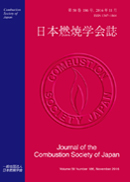Volume 46, Issue 138
Displaying 1-6 of 6 articles from this issue
- |<
- <
- 1
- >
- >|
FEATURE—Combustion Research in Fire Safety
-
Article type: FEATURE
2004Volume 46Issue 138 Pages 209-216
Published: 2004
Released on J-STAGE: October 24, 2019
Download PDF (989K) -
Article type: FEATURE
2004Volume 46Issue 138 Pages 217-223
Published: 2004
Released on J-STAGE: October 24, 2019
Download PDF (830K) -
Article type: FEATURE
2004Volume 46Issue 138 Pages 224-232
Published: 2004
Released on J-STAGE: October 24, 2019
Download PDF (1008K)
SERIAL LECTURE—Environmental Catalyst and Combustion Engineering II
-
Article type: SERIAL LECTURE
2004Volume 46Issue 138 Pages 233-241
Published: 2004
Released on J-STAGE: October 24, 2019
Download PDF (1012K)
ORIGINAL PAPER
-
Article type: ORIGINAL PAPER
2004Volume 46Issue 138 Pages 243-250
Published: 2004
Released on J-STAGE: October 24, 2019
Download PDF (878K) -
Article type: ORIGINAL PAPER
2004Volume 46Issue 138 Pages 251-259
Published: 2004
Released on J-STAGE: October 24, 2019
Download PDF (1146K)
- |<
- <
- 1
- >
- >|
